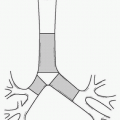Gastroduodenal Stent Placement
Jin Hyoung Kim
Ho-Young Song
Chang Jin Yoon
In 1991, Song et al. (1) described the first metallic gastric stent placement in a patient with a gastric outlet obstruction due to recurrent gastric cancer after bypass surgery. The first covered metallic gastroduodenal stent placement, through a surgical gastrostomy using local anesthesia, in a patient without prior bypass surgery was also reported by Song et al. (2) in 1993. In 1995, Strecker et al. (3) published the first report of a transoral stent. Since then, transoral placement of metallic stents has been increasingly used for safe nonsurgical palliation of unresectable malignant gastroduodenal obstructions (4,5,6,7,8,9,10,11,12,13,14,15). The procedure is performed either under fluoroscopic guidance alone or combined with endoscopic guidance. Transoral placement has a higher clinical success rate, lower morbidity and mortality rates, and a shorter length of hospital stay than surgery (16,17).
Indications
1. Documented unresectable malignancy resulting in gastroduodenal obstruction
a. Intrinsic tumors including stomach and duodenal cancers
b. Extrinsic gastroduodenal obstruction due to pancreatic malignancy, cholangiocarcinoma, malignant lymphadenopathy, localized intraperitoneal metastasis, or lymphoma
c. Surgical gastroenteric anastomotic site
2. Patients whose life expectancy is more than 1 month
Contraindications
Relative
1. Mildly symptomatic patients
2. Clinical evidence of perforation, peritonitis, or severe coagulopathy
3. Multiple obstructive lesions of the small bowel (e.g., peritoneal seeding)
4. Severely ill patients with a very limited life expectancy
Preprocedure Preparation
1. Obtain informed consent after explaining the procedure, its risks and benefits, and alternative therapies.
2. Insert a nasogastric tube at least 24 hours before the procedure to ensure adequate gastric emptying. An empty stomach becomes cylindrical and permits easier catheter manipulation and advancement of the stent-delivery device (18).
3. Check hematocrit, platelet count, prothrombin time (PT), and partial thromboplastin time (PTT) and correct as necessary.
4. Barium studies and/or endoscopy to evaluate the site, severity, and length of the stricture
Procedure
1. A variety of bare or covered expandable metallic stents have been used in the treatment of malignant gastroduodenal strictures: the Wallstent (Boston Scientific, Natick, MA), Ultraflex stent (Microinvasive/Boston Scientific, Natick, MA), Gianturco Z-stent (Wilson-Cook, Winston-Salem, NC), Niti-S stent (Taewoong Medical, Ilsan, South Korea), Hanaro stent (M.I. Tech, Pyeongtaek, South Korea),
and dual gastroduodenal stent (S&G Biotech, Seongnam, South Korea). Various stent-delivery systems are used, and they range in diameter from 3.8 to 28 Fr.
and dual gastroduodenal stent (S&G Biotech, Seongnam, South Korea). Various stent-delivery systems are used, and they range in diameter from 3.8 to 28 Fr.
2. The procedure is performed under conscious sedation and analgesia (e.g., intravenous midazolam and fentanyl) (19,20). The pharynx is anesthetized with 1% lidocaine spray.
3. Patients are placed in the right lateral decubitus position, and then a 0.035-in. exchange guidewire (Radifocus M, Terumo, Tokyo, Japan) and a catheter (100 cm, 5 or 6 Fr.) are inserted through the mouth across the stricture into the distal portion of the stomach or duodenum under fluoroscopic guidance (Fig. e-80.1A). Looping of the catheter guidewire system can be reduced by use of a 12 or 18 Fr. guiding sheath (21).
4. Once the catheter has passed beyond the stricture, water-soluble contrast medium is injected to delineate the anatomy (Fig. e-80.1B).
5. When the catheter has been advanced into the proximal jejunum, the guidewire is replaced with a 260-cm exchange length Amplatz Super Stiff wire (Meditech/Boston Scientific, Watertown, MA).
6. In very tight stenoses, predilation with a 10-mm balloon can be performed to allow easy passage of the stent-delivery system (12,15,22). The stent is deployed under fluoroscopic guidance and should be 2 to 4 cm longer than the stricture to reduce the risk of tumor overgrowth (18) (Fig. e-80.1C,D).
7. In patients with a technical failure in negotiation of the guidewire through the stricture with fluoroscopic guidance alone, combining endoscopic guidance should be considered.
8. In patients with a stricture longer than 10 cm, two or three stents can be placed in a stent-within-stent fashion to achieve complete coverage of the stricture (15).
9. Once the stent is placed, balloon dilation is usually not required because most self-expanding stents will gradually expand and reach their full diameter. However, if the stent expands less than half of its nominal diameter, stent dilation may be performed (12,15).
Stay updated, free articles. Join our Telegram channel

Full access? Get Clinical Tree





